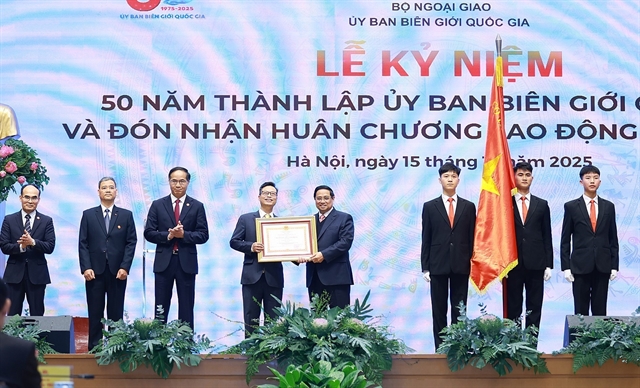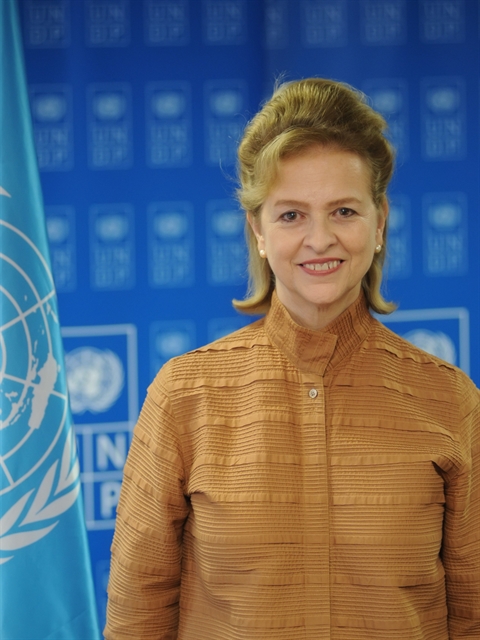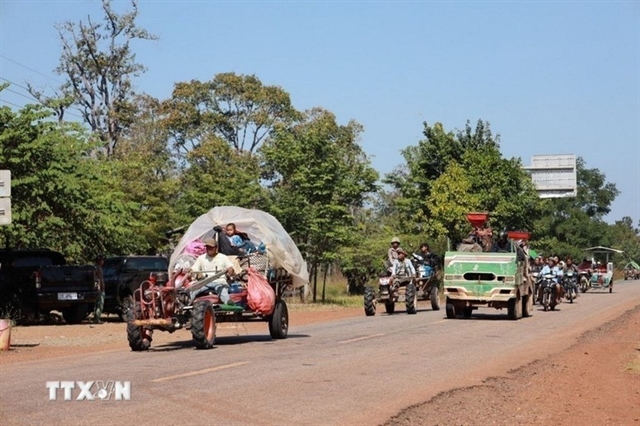 Society
Society

In recent interviews with Việt Nam News, an energy expert and industry leaders in the sector spoke to Vân Nguyễn about the country's commitments at the COP26 to transit away from coal, the impacts of the COVID-19 pandemic on its energy transition and recommendations for Việt Nam to keep its race to net-zero economy on track.
In recent interviews with Việt Nam News, an energy expert and industry leaders in the sector spoke to Vân Nguyễn about the country's commitments at the COP26 to transit away from coal, the impacts of the COVID-19 pandemic on its energy transition and recommendations for Việt Nam to keep its race to net-zero economy on track.

|
| Caitlin Wiesen, UNDP Resident Representative Vietnam |
Caitlin Wiesen, UNDP Resident Representative Vietnam
UN Secretary-General Antonio Guterres has declared the climate crisis the number one emergency of our time. To date, 193 states have agreed to keep the Paris Agreement target of limiting global warming to well below 2⁰C and preferably 1.5⁰C. At COP26, Việt Nam joined more than 70 other countries to commit to a net-zero emissions target by 2050 and coal phase-out in the 2040s. Accelerating the race to net-zero requires concerted efforts by all stakeholders, especially the private sector.
Việt Nam’s successful development of solar power between 2017-2020 and some wind over the past year is notable. However, shifting to net-zero requires that whole industries and sectors transform for scaling which in turn needs a commensurate expansion of professional human resources across sectors. FDI can play an important accelerating role through technology transfer and human resource training.
Critical to building on this initial success is developing a long-term policy, and predictable FIT for renewables that will allow investors to commit to long-term investments in renewable energy, enabling more stable long-term energy development of Việt Nam. Operationalising full wholesale and retail power markets by 2024 is expected to provide transparent, fair, and competitive environments for investors, suppliers, service providers and end-users. This in turn would enable more buyers of renewable energy leading to greater efficiencies.
We hope that the upcoming power development plans No.8 will provide a clear roadmap for the development of renewable energy and predictable FITs so that investors can plan and make long-term commitments to invest in renewable energy in Việt Nam which will significantly boost investments. Making the shift to green production and consumption will also take a whole-of-government and whole-of-society approach for a sustainable future in Việt Nam. There are many investments that are needed over the long run, but it is very important to get policy and regulatory frameworks correct now so that we can crowd in the investment Việt Nam needs at this time for renewable energy. The good thing is that so many private sector entities, both national and international, are keen to invest in Việt Nam. If governance bottlenecks are addressed, it will help the country go a long way in its energy transition.

|
| Alain Cany, Chairman of the European Chamber of Commerce in Việt Nam |
Alain Cany, Chairman of the European Chamber of Commerce in Việt Nam
For Việt Nam to achieve net-zero emissions by 2050, an integrated public-private effort must be coordinated across all aspects of society, the economy, and the government. Collaboration with foreign companies and institutions can help reach this goal. In particular, European FDI firms have extensive experience with eco-friendly initiatives and best practices, making them uniquely positioned for collaboration with Vietnam.
A transition to a clean energy economy will also require significant financial resources. Funds are needed to phase out carbon-intensive industries, promote green businesses, and increase renewable energy access. Mechanisms for public-private partnerships and private investment in green energy projects need to be adjusted to avoid roadblocks in the development of necessary renewable energy infrastructure.
To meet the demand for human capital, the government must provide workers with training, recruit high-skilled workers, and provide favourable visa and work permit policies to attract international experts for the purpose of developing Vietnamese talent.
Following the pandemic, recovery solutions are crucial in the short term, while an energy transition will require decades of sustained funding and support. In comparison with urgently needed pandemic recovery policies, an energy transition may seem more distant, and more difficult to justify. In addition, the ongoing instability resulting from the war in Ukraine has made short-term economic remedies even more critical, requiring world leaders to allocate limited resources to combat inflation, repair supply chains, and stabilise commodity prices. Due to these dual crises, governments and businesses have had a difficult time finding funding for long-term but essential changes such as cutting fossil fuel consumption and producing more renewable energy.
Despite all the challenges, an energy transition is critical and urgent. Energy transition should be pursued together with pandemic recovery measures since doing too little will cost more than it will benefit. The government of Việt Nam recognises that the two cannot be separated. As a result, it is leading an economic recovery alongside an energy transition as outlined in Prime Minister Pham Minh Chinh's COP26 commitments and its National Green Growth Strategy.
Through post-pandemic recovery policy interventions, the implementation of incentives, and financing mechanisms to promote green initiatives, Việt Nam's economy can be rebuilt more effectively than ever before based on a green, sustainable basis. Việt Nam can eventually become Southeast Asia's leader in green energy by following this path.

|
| Dr. Đỗ Nam Thắng, a research fellow at Crawford School of Public Policy, Australian National University |
Dr. Đỗ Nam Thắng, a research fellow at Crawford School of Public Policy, Australian National University
There are various ways in which FDI and foreign companies can involve. They can invest in green infrastructure such as transmission grids. Việt Nam now needs sizeable investments in upgrading the grid systems to accommodate renewable energy and also to meet increasing electricity demand. The investments can also be directed to energy storage, to help the uptake of renewable energy. The storage can be in terms of batteries or off-river pumped hydro energy storage.
The energy transition is a relatively new concept everywhere, especially in Việt Nam. The pace of the booming of renewable energy worldwide is much faster than the pace of the development of domestic regulations and administrative procedures to keep up. No process can happen overnight. It takes time to transit to renewable energy.
The policy is the key. If the policy is clear and stable, then the investors will have trust and take action. For example, Việt Nam could set a clear renewable energy target and the target needs to be stable. It could be changed, but at least in negotiation with those who have taken action, those who have built the plans and invested. That's important.
The energy transition is the world's future trend. The trend will involve opportunities and challenges. The government alone may not be adequate to go far enough. Community and industry are the key partners. I think for every transition and development, there are challenges, and even failures, especially at the beginning. If people are open to opportunities and failure, then I think the process will be made forward. If we don't want to change, we may not be able to go very far.
.JPG)
|
| Stuart Livesey, CEO of La Gàn Offshore Wind Farm Project |
Stuart Livesey, CEO of La Gàn Offshore Wind Farm Project
The offshore wind industry in Việt Nam is nearing a turning point to start the process, however, there are several aspects that need to be resolved to allow this. A robust, suitable and practical regulatory and policy framework needs to be created and enforced to allow developers a route to market. This needs to be equally supported by a bankable power purchase agreement (PPA) so it is clear how costs can be covered for this high-cost industry in the early stages of its maturation.
Experience in relation to installing offshore wind in Việt Nam is limited to nearshore wind projects only (most being established within three nautical miles). Offshore wind farms are installed in a completely different manner, with much more complexity in terms of the vessels used and infrastructure installed, and the risks involved with establishing these high-cost projects.
While it is true to say the infrastructure, human resources, and finance for offshore wind now are limited, there is a significant potential for Việt Nam to very quickly resolve this by transitioning skills from similar industries (such as offshore oil and gas), considering the ability to adapt the local supply chain in the long term, and encouraging experienced foreign developers to participate in the early stages of the industry to allow a stable growth and lessons learnt to be shared with suppliers and local Vietnamese companies, in addition to the ministries and provinces that will be associated with such projects.
Other markets have shown that by supporting the growth of a new offshore wind industry with the introduction of demonstration projects, feed-in tariffs, transition mechanisms, among others.
Taiwan has shown consistent reductions over the past six years from initial feed-in tariffs (FITs), to transitional mechanisms, and now to competitive auctions, with approximately 60 per cent cost reduction over the past six years. Taiwan’s ability to attract foreign investment, which ultimately has led to massive reductions in subsidy levels has only been possible by recognising the demand for energy would increase, as would the demand for green energy based on domestic and international policies and regulations for local generators/consumers and associated requirements for import and export tax on good manufactured in Taiwan.
The development of multiple projects in the same area will require active and continuous government coordination, but this ability to have a clear sight of future opportunities will provide reassurance for developers and suppliers to invest and commit further in their offshore wind activities within Việt Nam. VNS




